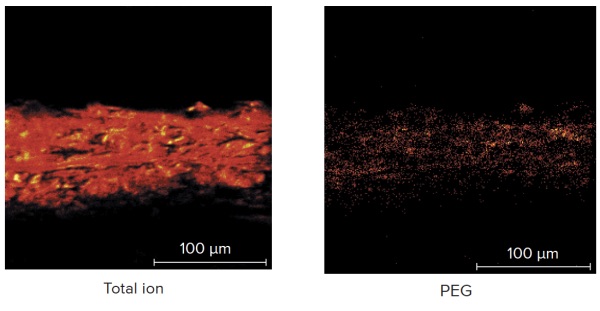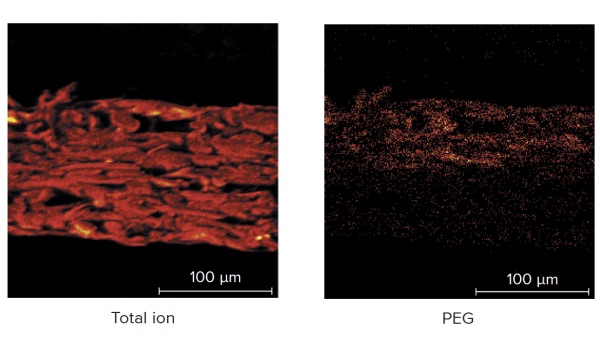Imaging Cross-Sections by TOF-SIMS
Home » Imaging Cross-Sections by TOF-SIMS
Time of Flight-Secondary Ion Mass Spectrometry (TOF-SIMS) provides molecular information with high spatial resolution, making it well suited for imaging the distribution of individual organic molecules. However, most of the applications are limited to low molecular weight ions. Unfortunately, many compounds lack characteristic peaks in the low mass range. In the low mass range, the major peak of PEG (polyethylene glycol) appears at m/z 45, but this ion can also come from any compound containing the C2H5O+ group. In this research, PEG retained in the cross-section of ink-printed paper was studied. The distribution of PEG in the cross-section of two different kinds of paper was examined by imaging high molecular weight ions, which are characteristic peaks for PEG.
SIMS spectra and images were obtained using a 69Ga+ ion source was operated at both 15kV and 25kV. Charge compensation was accomplished with a low energy electron beam. The surface and the cross-section of the unprinted and printed paper were analyzed. Both high mass resolution spectra and high spatial resolution images were obtained.
The spectra in the mass range m/z 400-600 obtained from the cross-sections, both non-printed and printed smooth paper, are compared in Figure 1.

Three series of peaks with an interval of 44Da (labeled as “*”, “o” and “+”, in the spectra) are observed in the mass range above m/z 400 in the spectra of the printed paper only.
Based on the unique repeat unit mass of 44Da ([CH2CH2O-]n), it can be concluded unambiguously that these peaks correspond to PEG. Similarly, PEG peaks were also detected on the cross-section of the printed rough paper. This suggests that PEG is a component of the ink and that PEG in the ink penetrates the surface and migrates to the interior of the printed paper.
To examine the distribution of PEG in the cross-section of the printed paper, a group of PEG characteristic peaks in the high mass range (m/z 443, 457, 473, 487, 501, 517 and 531) were imaged. The images obtained from the cross-sections of the smooth and the rough paper are compared in Figures 2A and 2B. The result shows that PEG is enriched at the top half of the rough paper, while it is distributed more homogeneously in the smooth paper. The surfaces of the non-printed paper and the printed paper were also examined. Again, PEG peaks were only observed in the surface of the printed paper. This work demonstrates the capability of TOF-SIMS for determining the spatial distribution of organic polymers in insulating samples.


Would you like to learn more about Imaging Cross-Sections by TOF-SIMS?
Contact us today for your imaging cross-sections by TOF-SIMS. Please complete the form below to have an EAG expert contact you.